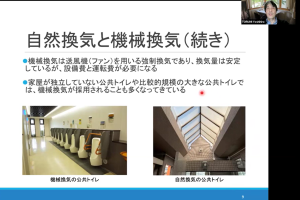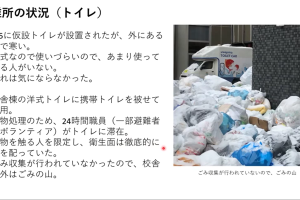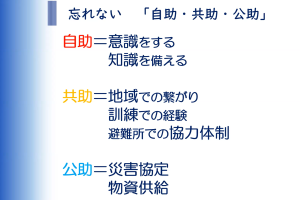Japan Toilet Association (JTA) Seminar Series; “Let us know more about our Toilet Story”
Date: 19 October 2023 (Thu) 18:00-20:00 JST
- Master of Ceremony (MC)
- Mikiko Takahashi, Ph.D. (Director of JTA, Manager of R&D Division of Comany Inc.)
- Presenters
- Mameta Endo (Head of Nijizu General Incorporated Association, trans man)
- Minori Tokieda (Executive director of the General Incorporated Association LGBT Law Association, trans woman)
- Yuko Noguchi,Ph.D. (Professor at Nippon Institute of Technology, on different-gender assistance for the elderly dementia patients when using the toilet)
Lecture Outline
(Takahashi) The all-gender toilets are located in many places in Japan at the airplanes, train stations, shopping centres, offices, and parks. I would like to ask the opinions of today’s all participants on whether they are reluctant to use such toilets installed in the public toilets. Please respond to the survey on the web, and the results will be introduced later.
Recently, the all-gender toilets have been increasing. However, in some cases, there are various issues. For instance, the all-gender at an amusement centre in Shinjuku was closed only four months after opened.
There are various expressions about the all-gender toilets, such as “the all-gender toilets”, “genderless toilets” or “gender-free toilets.” “Genderless” is used to mean eliminating gender differences. “Gender-free” is used to eliminate the discrimination based on the gender. However, these English expression terms were created in Japan, therefore the overseas people cannot understand the meaning.
I think that the all-gender toilet means that people of any gender can use it. Consequently, the expression “the all-gender toilet” must be most appropriate one. JIS (Japanese Industrial Standards) Z8210 assigns the pictograms for the all-gender toilet. Therefore, the label shall be “all-gender” in Japanese and it shall be also written as it in English.
1. Presenter; Mameta Endo

The general incorporated association “Nijizu” where I am representing and keeps a place for LGBT children and young people. Most of the people are junior high school and high school students. They are transgender people.
Firstly, I would like to introduce my favourite toilet.
There are toilets in Swedish railway stations that can be used by the all-genders. Each cubicle is numbered, and the station staff will lend you the key. There is also a washing basin and a mirror inside the cubicle. I think this type to be the easiest to use. I can use it without thinking about my gender, and there are no blind spots. The place to wash the hands is shared in Japanese public toilets with other people and this is an area that can easily become a blind spot.
The hand-washing areas at most schools are shared, and when these are blind spots, bullying is likely to occur. Having fewer blind spots is something to consider not only in terms of sexual crimes but also bullying. The toilets and changing rooms were cited as places where bullying and harassment occur in a survey of LGBT for the students. The violence often occurs in places that cannot be seen from the outside and then I think the Swedish approach is ideal.
The toilets in small and independent stores in Japan are often for the all-genders, and I feel little hesitation to use this. The toilets in some stores with many tenants in large buildings are shared on that floor and are separated by the gender. This place is somewhat difficult for me to use.
When I am usually thinking about what to do in the day, I am conscious of where the toilets are easy to use for me. I did not have to think about that in Sweden, and was really favourable ones.
There are toilets in Taiwan that can be used by both genders. The toilets at Taipei City Hall are marked as “All-gender toilets.” There are various types of the private cubicles with the urinals. There is another separate women’s toilet for those who are uncomfortable share with men. Some toilets provide the free sanitary products.
When I go out, I predict which toilet will be safer for me. I prefer the toilet is not crowded. The train station toilets are often crowded. I worry if someone doubted my gender, I feel anxious. It may be seemed like useless information for the ordinally people, but I have accumulated information about the toilets in various places in my head. I dislike the long business meeting in the stops that only have separate toilets for men and women. Whenever I travel to different cultural background places, I worry about what others think of my behaviour.
Asian people look small and looking young faces. Therefore, even if there are some females like traits, they are often treated me as men in America much more than in Japan. When I travel by a bus tour abroad, everyone goes to the toilet at the same time. It is quite troublesome when I do not know what type of the toilet is there.
My health insurance card says I am female. I am worried that it would be suspicious in the hospital if I handed the urine test item in through the small window in the men’s toilet. One time, I handed it in through the men’s toilet and nothing happened. Nowadays I am accustomed to hand it in through the men’s toilet.
I often use wheelchair-accessible toilets, but I worry that I might be reprimanded. In fact, I was once asked why I was using it. The wheelchair-accessible toilets in Japan are often also multi-functional toilets with an equipment of the ostomates and diaper-changing bed. Some multi-functional toilets are locked and cannot be opened without a request by the intercom. I have even been told to use the men’s toilet when I spoke to a staff by the intercom.
When there is no multi-functional toilet, I sometimes use the men’s toilet, but the cubicles are often occupied. They keep long time, and I think they are relaxing there rather than excrement.
(Q1: Takahashi) Which toilet would Mameta-san prefer to use? The men’s toilet or the all-gender toilet?
(A1: Endo) The all-gender toilet is better. When toilets are separated by the gender, it feels like I may be questioned about my sexuality. I wish the signs simply displayed “Toilet” instead of “Men’s toilet,” “Women’s toilet,” or “All-gender toilet.” The convenience store toilets are easier to use, as they give me feeling that anyone can use them. Multi-functional toilets are also easier to use. I wish people would not reprimand too much for using them for only a short time.
(Q2: Takahashi) If there are a wheelchair-accessible multi-functional toilet and an all-gender toilet that is not so large, which one would be preferable for you?
(A2: Endo) I do not mind multi-functional toilets, but will not need to be spacious, so the all-gender toilets would be fine. A Swedish high school teacher once said, “Being made conscious of one’s identity is oppressive.” The changing area at the school is used by the several people. A pupil who wants to change alone must explain their religion or physical situation and must get the teacher’s permission. It is ridiculous to make conscious of these matters only when changing clothes.
The toilets are preferable like those in Sweden, where everyone can use them without caring about the self-gender. Recently, a new toilet was built with extra all-gender cubicles in Tokyo, but it was severely criticized online and was forced to close. There is a tendency in this society to not tolerate things that do not match their values, and it seems all new initiatives must be criticized. This is a tendency to be difficult to speak out our opinion that the necessity for increasing the all-gender toilets.
There is a lot of talk about the troubles which we, the transgender people face about the toilets. However, there are also many people who have made some progress in their gender transition and are not having any trouble. I can manage to use the toilets with some ingenuity. I think it is unbalanced that too little attention is focused to the cases like there are no problems for some groups
2. Presenter, Minori Tokieda

A few years ago, I founded a citizens’ group based at Kita Ward, Tokyo, and has been active ever since then. I have worked to accelerate the partnership system and to enact an anti-LGBT discrimination law. The partnership system here means that Japanese law determined only heterosexual marriage is recognized. This system allows the local governments to independently recognize LGBT couples as having a “relationship equivalent to marriage,” making it easier for them to receive various social services.
As a transgender person myself, I have been involved in a variety of activities, including giving lectures and training, and making the policy recommendations regarding SOGI (Sexual Orientation and Gender Identity). Until high school days, I appeared as a male student. I felt somewhat uncomfortable living as a man. I graduated from the high school and no longer had to wear a male uniform or live a stereotypical male life, I gradually transitioned myself over the years.
I now use the ladies’ toilet, depending on the case I use the all-gender toilet, or multi-functional toilet. I worked as a male at the company until a few years ago. I would stand out, and men would sometimes be surprised when I went into the men’s toilet when I dressed too femininely. However, I could not use the ladies’ toilet, so I had no choice but to go to the toilet that was easiest for me to enter, even if it was too far away. I hesitated to enter when there were other people in the toilet. Then I would sometimes just hold it in and give up using the toilet.
I started to get involved in the related social activities a few years ago, and I started to meet the other transgender people and make connections with the LGBTQ community. I started to feel more secure knowing that I am not alone, and I was gradually able to use the women’s toilet naturally. Of course, it depends on my stage of the transition.
There was only one all-gender toilet available for the office, when I worked for a relatively small company. Whereas, there were more options for the toilets available, when I worked for a company in a large tenant building, and I felt easier to use one.
In many cases, there are not multi-functional toilets on all floors. I would go to a floor with a multi-functional toilet and must rush back during short breaks at the work time. Sometimes I was late returning from my break but I could not explain the reason. It must be easier to work if the break time does not the same for the whole workplace. If each employee can take the own break, then there will not be crowded or concentrated to use the toilets at a short period. The ease of the accessing to a toilet varies depending on the various factors, such as the working style of the company and whether or not there is a shift system.
There is a lot of discussion about the toilet facilities inside the commercial facilities and public toilets, but the flow of people to reach the toilet is also serious issue. I feel it easier to use toilets in places without crowded or vacant. I am self-conscious about being seen by others, so I wish to use the toilet without it. I will not use the toilets with the security guard. Whenever I enter a toilet, I am very conscious of the gazes of others and the situations around the area of the entrance and exit.
LGBT Awareness Promotion Act (Act on Promoting Public Understanding of Diversity in Sexual Orientation and Gender Identity) came into effect in June 2023. However, there was strong opposition to the act among some diet members. Some of them have an opinion that women-only toilets should be reserved. Also, some people are arguing based on the mistaken understanding that a trans woman who have not undergone surgery are still man. I personally feel that it is important to install the all-gender toilets, but I do not think the discussion should be trivialized as an issue of only transgender people.
3. Presenter, Noguchi Yuko, Ph.D.

I have done various researches on the different gender assistance for the people with dementia or developmental disabilities and the all-gender toilets. I published a handbook on the toilets for the people with dementia in November 2019. There is an example that a wife and her husband with the dementia went into the different toilets at a gender-segregated toilet. The women’s toilet was crowded, and it took a long time for the wife to finish. The husband came out early, and forgot his appointment to meet his wife and disappeared.
There are many such cases, and I have heard many such cases, and in some cases the missing person has never actually been found. A wife who was actually having more trouble using the toilet than her husband who was dementia, and they tried to find a toilet that both of them can use in the same space together. A son was helping his mother who was dementia, and he was unable to enter the women’s toilet with her alone, and then he loudly called out from outside, “Mum, are you OK?” A kind woman passed by saw this and helped them and the son was quite relieved. It would be lucky if such a kind woman happened to help, but this is not always the case.
When a wife goes into the women’s toilet, her husband who is her caregiver will wear a sign which notices “Caregiving” and go in with her. The opposite case also happens. There are also cases where a husband will take his wife into the men’s toilet. In either case, users often say that they feel strange looks from others, which is very embarrassing for them. There are actually a lot of cases where a person with dementia goes into a cubicle alone, but cannot find the way how to open the lock and is trapped eventually.
In addition to the Dementia Handbook, we also published a Public Toilet Handbook for people with the developmental disability. Research where this handbook is based a questionnaire survey with 1,164 parents at the special needs schools and rehabilitation centres in Yokohama. It was found that more men than women have developmental disability. About 80% of them go to shopping facilities where they go on holidays. They most often go out with their mother at 87.5%. Considering this situation, it is conceivable that a mother will assist her son at the toilet. This also shows the necessity for the all-gender toilet.
When asked if they had ever experienced any problems in public toilets, 77.5% answered that they had experienced. They were suffering from its dirtiness and smells as the main problems, followed by the assistance problem of the different gender assistance. However, the figures for these two were quite close, and the percentages of them were very high. Some responses also said that a couple of the mother and son was unsure of whether to use the men’s or women’s toilet.
When asked about the use of multi-functional toilets, it was not only children with developmental disabilities who use them, but also their parents. 68% of protectors used multi-functional toilets. The most common reason given by around 60% of parents was that they could not make their child wait outside when the parents use the toilet. Being assisted by a member of the different gender come in the third place, accounting for around 30% of the responses. Over 40% answer when asked about problems using multi-functional toilets was worrying about whether a wheelchair user would wait to use the toilet.
The third answer was that users feel worry when using it for long periods of time. Overall, the survey results showed that while toilets are not necessary to be as spacious as the wheelchair accessible toilets. Many of them would find it helpful if there is the all-gender toilet with reasonable enough space. Then the different gender assistance becomes confident for them.
(Takahashi) Let me tell you the results of the survey we asked at the beginning about whether you would use all-gender toilets. 15 men and also 15 women were replied. The question was whether they would be reluctant to use the all-gender toilets in the airplanes.Over 90% of men replied that they would not be reluctant. 60% of women replied they would have no reluctance, and 13.3% said they would rather not be reluctant. In other case, 26.7% of men were reluctant, and over 50% of women were reluctant, when it comes to the all-gender toilet in the train stations.
The same trend can be seen in the shopping centres. Many women feel uncomfortable using the all-gender toilets at work place. The survey of the participants this time showed that the level of hesitation to the all-gender toilets varies depending on the type of people who use and the facility.
(A3: Kawauchi) I would like to ask the women, why is there less hesitation to use the toilets in the airplane?
(A3: Ms. OT) I feel like there is less hesitation to the all-gender toilets on airplanes than at the train stations. It seems like there are more blind spots at train stations than on airplanes. The facilities are designed to ensure the privacy, as there are a lot of the passengers in the airplanes.
(Q4: Kawauchi) The women often claim that they are reluctant to use the same toilet with the men. However, the toilet safety is a priority in your case?
(A4: Ms. OT) I put a toilet paper on the seat instead of a seat cover because of the hygiene reason. I will always put it in either women’s or the all-gender toilet. Therefore, my main concern is to shift to its safety.
(Q5: Kawauchi) If there was a toilet seat cleaner, would you feel less averse to sharing the toilet with men?
(A5.1: Takahashi) I do not use the toilet seat cleaners even though available. I am reluctant to use the all-gender toilets. In the matter of the fact, there are sometimes drops of the men’s urine on the toilet seat. What do other women think?
(A5.2: Ms. HT) I don’t feel uncomfortable in the all-gender toilets. If the toilet is defiled, I wipe it by myself with a tissue. Even the women’s toilets are sometimes dirty, so I do not have any objections to the all-gender toilets.
(A5.3: Ms. AD) When there is the all-gender toilet or wheelchair-accessible toilet and there is no one else nearby to use it, I will positively use it. The wheelchair accessible toilets are the all-gender style in Japan and often have a separate entrance from the men’s and women’s toilets. It is more reason for the safety and ease to enter rather than for the hygiene. I think the most important thing is toilets that are easy for a diversity of people to use including size matter.
(A5.4: Ms. TK) I am very reluctant to use the all-gender toilets. I am very concerned about the hygiene. Sometimes the toilet seat is kept up after a man used it. As we get older, we need to go to the toilet more often. When urgent to go quickly, it is bothering to put the toilet seat down. I looked after my parents about 10 years ago, my father was assisted by me as a woman, so I struggled with whether to use the men’s or women’s toilet.
I think the manners of people using the toilet are quite important.
(A5.5: Ms. HN) I have a strong aversion to the all-gender toilet. I have had several bad experiences in stores where is only an all-gender toilet. There was a lot of urine spilled on the floor. I have weak eyesight and I sat down without noticing that urine and ended up with soiling my clothes. I have even been given a cricking tongue by a man waiting outside when I came out after using the toilet. In fact, I really have never had a good experience with the all-gender toilet. Therefore, I try not to use them if possible.
However, I sometimes go in without any hesitation in places that are very clean and tidy. Of course, the safety is the top priority for any public toilet, not just the all-gender toilets, but I think cleanliness will be positioned the second important condition.
(A5.6: Ms. AZ) I do not have much of a problem with the all-gender toilets. However, I will use women’s toilet, when there is. I used the multi-functional toilet for its spaciousness, when I was caring for my mother. In fact, the safety is the first prerequisite at the all-gender toilet, as well as the cleanliness and hygiene.
I feel uncomfortable when the toilet seat is up. I can just wipe the urine drop off with the toilet paper and then use it.
(Q6: Kawauchi) I cannot really understand the sense of discomfort when the toilet seat is up.
(A6 Ms. KB) I think it is because there is a preconceived notion that after a man uses it, it is felt dirty unconsciously.
(Q7: Kawauchi) I think everyone here gathering today understands the necessity of the all-gender toilets. The critical issue here is not whether the all-gender toilets are acceptable, but how to increase the recognition for the all-gender toilets.
(A7.1: Mr. KS) I personally have no objection to the all-gender toilets. I think that if every cubicle had a hand-washing basin, then all users may be less resistant to the all-gender toilet. I think women would be more sensible to do washing their hands next to a man at the sink place in the all-gender toilet.
(A7.2: SZ) The women’s toilet feel like the sacred places from a man’s perspective. It’s hard barrier to go in. When I can hold myself, I will try to find and use the men’s toilet.
(A7.3: Mr. SW) I do not like sharing a toilet with my acquaintance. That is a reason why I do not like using toilets at work and on airplanes. I use the same toilets as my co-workers at the work place. If it is an all-gender toilet, I feel embarrassed to go into a female acquaintance in that toilet. I hesitate the person sitting next to me to use the same toilet on an airplane after me and start regretting that it was dirty by me.
(A7.4: Mr. HS) I have no objection to the all-gender toilets. I visited Sweden when I was a student. Sweden is quite a gender-equal country where men and women are completely equal position, and there are many areas where the distinction between male and female is less conscious. The toilet system is such that everything necessary can be completed within just one toilet cubicle.
(Q8: Kawauchi) Women tend to dislike when men defile the seated toilet bench with the urine. I think all men in overseas must be same, but why do women in other countries do not mind it? I think Japanese women would never forgive seriously a man if they found out he was soiling it.
(A8.1: Mr. KS) I stayed Texas, USA close to Mexico in for a while. There was a single cubicle toilet, but always it was clean. The all men used it quite cleanly and politely.
(A8.2: Ms. HN) The noise silencer device is set in some Japanese toilets. However, I have heard American people feel strange it. I think the sense of embarrassment about noise is different in each cultural background.
(A8.3: Mr. HS) The chair of American Restroom Association (ARA) published a book about the toilet phobia. It is because of a neurosis, and millions of people around the world cannot afford to use the toilet outside.
(A8.4: Mr. HR) I use a wheelchair. The wheelchair-accessible toilets are normally the all-gender toilet. Therefore, I have no objection with it.
(Q9: Takahashi) Regarding to the all-gender toilet, now it is gradually cleared about the requirements; safety, cleanliness, embarrassment, and the aversion using it with men.
(A9.1: Mr. UE) The toilet manufacturers come up with all sorts of innovative ideas, but I wonder if all users are using them properly. Is the sitting toilet bowl originally designed for men to urinate while standing? Or designed sitting down to urinate? I think it is unclear. I also think it is important to design the toilet placement so that the users do not make eye contact with people around when entering and leaving the toilet.
(A9.2: Mr. NK) We once produced the bench style toilets with different shapes for men and women to use in offices. I do not know how much research was done on ergonomics at that time, but the men’s bench style toilet was spacy in the front portion and easy to use. One idea is to install a urinal in the cubicle of the all-gender toilet. However, this may require a large toilet cubicle space. Some women may claim that the mere presence of a urinal makes them uncomfortable.
(Q10: Takahashi) Particularly in the case of the all-gender toilet, some gaps in the partitions will leak out the noise. It is especially important to install them without any gaps there.
(A10: Ms. KB) I think the main subject of today’s talk was to discuss ways to eliminate hesitation to the all-gender toilets. I am not sure whether the hesitation is due to feelings that come from the cultural background, or whether it is a matter of disliking of the defile. I think the main issue is what method we, ourselves should choose, rather than the other countries situations.









